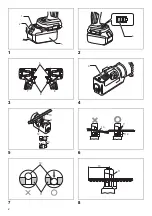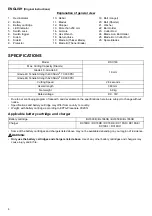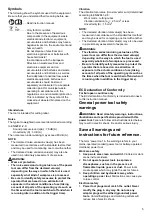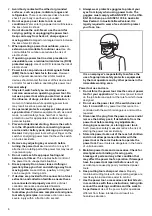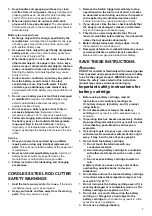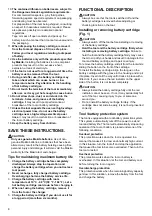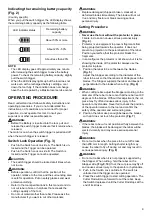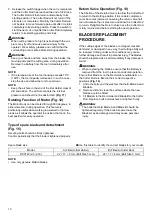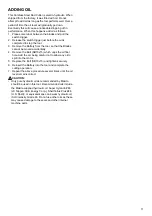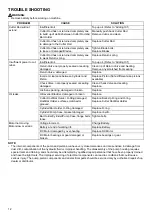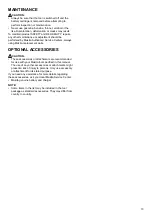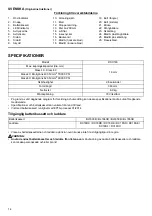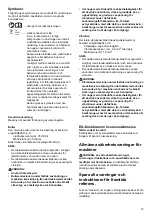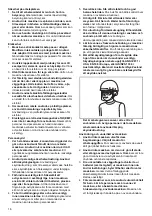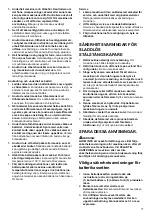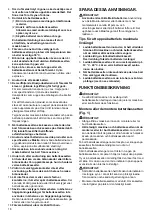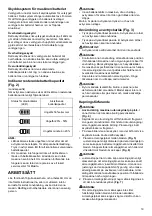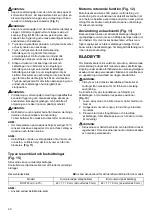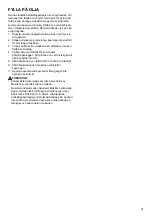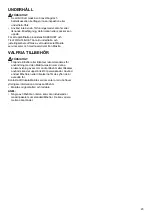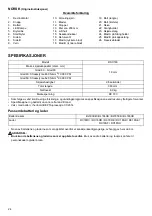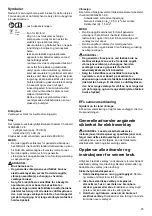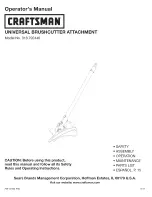
10
5. Release the switch trigger when the cut is completed
and the Cutter Rod has reached the end of its stroke.
The Cutter Rod will then return automatically to its
starting position. The Cutter Rod will not return if the
stroke is not completed. Similarly the Cutter Rod will
not be able to move forward again until after it returns
completely to its starting position. Press the switch to
start the next cut, only after the Cutter Rod completely
returns to its starting position and stops.
WARNING:
• When cutting rebar of a high tensile strength the cut
piece may fly off and cause serious injury to the
operator. Wear safety glasses and confirm that the
surrounding area is safe before starting operation.
WARNING:
• Keep your hands and face away from the blades, the
moving parts and the cutting area, during operation.
Remove the Battery from the tool immediately after
use.
NOTE:
• If the temperature of the tool housing exceeds 70°C
(160°F), the tool capacity decreases. In such a case,
stop the use and allow the tool to cool down.
NOTE:
• Keep the air hole in the end of the Bar Holder clear of
dirt and debris. The air hole controls the internal
pressure and should not be obstructed.
(Fig. 11)
Rotating Function of Motor (Fig. 12)
The Motor Body can be rotated through 360 degrees, in
either direction, during operation. This feature is
particularly useful when working in awkward or narrow
areas as it allows the operator to position the tool in the
best position for easy operation.
Return Valve Operation (Fig. 13)
The function of the Return Valve is to allow the Cutter Rod
to return to the starting position if it is unable complete a
cut or becomes jammed. Loosening the return valve half
turn will release the oil pressure and allow the Cutter Rod
to return. Retighten the Return Valve once the Cutter Rod
is fully returned and before starting the next operation.
BLADES REPLACEMENT
PROCEDURE
If the cutting edges of the blades are chipped, cracked,
deformed, or damaged in any way, their cutting ability will
be reduced. Cutting under such conditions may cause
further damage and result in personal injury. The blades
should be replaced as a set immediately if any damage is
found.
WARNING:
• When replacing the blades, ensure that the Battery is
removed from the tool to prevent accidental operation.
Ensure that Blade A, on the Bar Holder and Blade B, on
the Cutter Rod are fitted in their correct respective
positions.
(Fig. 14)
1. Undo the bolts and the washers that hold Blade A and
Blade B.
2. Remove dirt and clean the surfaces where the new
blades are to be fitted.
3. Fit Blade A to the Bar Holder and Blade B to the Cutter
Rod. Replace bolts and washers and tighten firmly.
WARNING:
• The bolts that hold Blade A and Blade B should be
tightened regularly. If the bolts become loose the
Blades may be damaged and may cause personal
injury.
Type of spare blade and detachment
(Fig. 15)
Securing bolts should be firmly tightened.
Confirm periodically that the blade is tightened properly.
Spare blade size
Use this table to identify the correct blades for your model.
NOTE:
• Use only genuine Makita blades.
Model
A (Fitted to Bar Holder)
B (Fitted to Cutter Rod)
DSC163 (ø3 - ø16)
22 × 17 × 9 mm (Bolt Size 5 mm)
22 × 17 × 8 mm (Bolt Size 5 mm)


